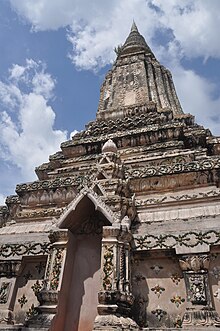Ang Duong
[3] Dedicated to extend the royal family line, Ang Duong had numerous wives and produced 18 legitimate children – 11 sons and 7 daughters.
Siam (modern day Thailand) which since the late eighteenth century royal investiture of General Chakri was governed by a well established dynasty and Vietnam united since 1802 under Emperor Gia Long increasingly fought over control of the fertile Mekong basin, the Cambodian heartland.
Vietnam subsequently gained military control of Cambodia and restored King Ang Chan, who had been dethroned by Siam.
Again Vietnam proved to be superior on the battlefield, however Siam was able to negotiate an agreeable peace treaty, by which Cambodia was placed under joint Siamese-Vietnamese suzerainty, a final act of complete disregard for Khmer national and royal authority.
In order to preserve the kingdom's national identity and integrity, King Ang Duong initiated secret negotiations in a letter to Napoleon III proposing some form of cooperation with France.
King Norodom Prohmbarirak signed and officially recognized the French protectorate on 11 August 1863, that was effectively incorporated into the Indochinese Union in 1867.
The historic reality of 19th century Asia reminded any local ruler to seek alignment of some form or the other with at least one of the then technological more advanced Western powers.
Ang Duong's death in October 1860 and accumulating foreign pressure convinced his son King Norodom Prohmbarirak to agree to the initially rather moderate French terms.

